When we think of the suffering endured by Jesus on that Friday morning, we think of the path He took and the trials He suffered along the Via Dolorosa and on top of the hill of Golgotha. Jesus started the path near the Fortress Antonio and the Lithostrasa, on the north-west side of the Temple, through the Gannath Gate, towards a cross road and a rocky outcropping where He finished the route. The end of the route, or the rocky hill top, also called Golgotha, or the Place of the Skull, is where Jesus gave His life for the sins of mankind. This is the site Jesus suffered His final sacrifice, was buried, and rose again three days later. Please visit my two posts about the Church of the Holy Sepulchre Part 1 and Part 2 for a more detailed description about Golgotha.
This post will chronicle the pain and suffering Jesus endured on Good Friday as He marched the Via Dolorosa. The information described in this post comes from my experiences living in Jerusalem and growing up a Christian. When I was younger I didn’t really understand just how much Jesus suffered for us. Yes, I read the Bible and knew the story very well, but I didn’t really know the true pain besides His death. My knowledge was paper thin, with no real life experience attached to it. My time in Israel taught me so much, and this is something I want to pass along to you. I hope by reading this you gain a better appreciation of His sacrifice and suffering.
I wanted to wait to post this for the right time of the year, Holy Week. Additionally, with our current health crisis, I paused all my posts so people could focus on their health and safety. However, this story is a story of love for humankind. A story of sacrifice for fellow man. And, this is the right time to retell it in this post for inspiration to overcome our current troubles.
HISTORY SPARKS:
- The Via Dolorosa is the route taken by Jesus through Jerusalem to His death.
- Pilgrims make the walk to be closer to Jesus and there are thousands that come out to walk the route on Good Friday.
- There are 14 stations along the Via Dolorosa.
- The path and number of stations have changed over time, but the significance is the same.
Thursday Night
Before we walk the Via Dolorosa, we must talk about the night before. That Thursday, Jesus and His Apostles entered the Holy City, walked from the east to the south western side, and dined in the upper chamber of a house. During dinner, one of His Apostles left the group to betray him. Before the betrayer returned, Jesus and the other 11 Apostles headed through the lower city, down the Kidron Valley, and retired on the lower portion of the Mount of Olives. (See my blog about the Last Supper and the arrest of Jesus (still in work at this time, sorry, I will update with a link in the future.))
While the others slept, Jesus prayed to His Father. Later, a large group of people arrived, made up most likely of Temple Guards, Roman Soldiers, and Temple leaders, and they arrested Jesus. This arrest was not the kind and somewhat ‘gentle’ arrest that we see today. The common technique used by Roman soldiers for arresting someone involved practically dislocating their shoulder using a ‘chicken-wing’ technique while kicking the back of the lower leg to hobble the criminal. This started the pain and suffering Jesus endured until His death. This was late at night or early morning on Friday. Jesus still faced physical abuse by the Temple Guards during the night while on trial in front of the High Priest Caiaphas and the Sanhedrin before his torture along the Via Dolorosa.
Where to start
My friend Jean-Marc and I would often start our tours near the Jaffa Gate, walk south towards Mount Zion and the first main place we would visit was a room on the second floor of a building that is recognized as the closest place to where the Last Supper occurred. From there we walked the same footsteps we believed Jesus took to the Mount of Olives with his Apostles. We stopped in the Garden of Gethsemane to visit the Basilica of Agony. Then, from there we reentered the Old City through Lion’s Gate. A short distance inside Lion’s Gate is the 1st Station of the Cross and the start of the Via Dolorosa.
From there we walked the Via Dolorosa to the Church of the Holy Sepulchre. Add in some stops along the way and we typically surpassed 20,000 steps during our tours according to my fitness tracker. We did these treks after getting a good night’s sleep, we usually ate, we stopped to explain where we were, and we always carried water. Even with all these stops and amenities, we were spent at the end of the walk. Jesus did this while exhausted, hobbled, beaten and abused all while carrying a heavy cross. His feat truly was a miracle.
Jesus faces the Roman Governor and is punished
After his trial and conviction, Friday morning Jesus faced the head of the Roman Government stationed in Jerusalem, Pontius Pilate. Pilate did not like the leaders of the Temple and did whatever he could to torment the members of the Sanhedrin and the High Priest. Caiaphas wanted Pilate to sentence Jesus to death. Pilate chose not to do that at first. Jesus was a Jewish problem, not a Roman problem. Pilate chose to have Jesus flagellated. If you are not sure what flagellation is, that’s OK, I didn’t really know what it truly was until I was in Jerusalem.
Flagellation is brutal. The maximum lashes someone could receive is 39. Pilate sentenced Jesus to 39. Researchers have determined that any more than 39 would likely cause death. Therefore, 39 would do an immense amount of damage but not add too much risk of death. It is unknown what the cat o’ nine tales were made of, but the two main theories state either bone fragments or pieces of metal. The Romans stripped Jesus of His garments, most likely tied Him to a stone pillar to open up the surface area of His back, and flagellated him. 39 lashes. Each lash produced multiple wounds. Each lash broke skin and caused immense pain.

Two possible cat o’ nine tales used, one with bone and one with metal 
A column found at the 2nd Station. These columns were used when prisoners were tied up and flagellated
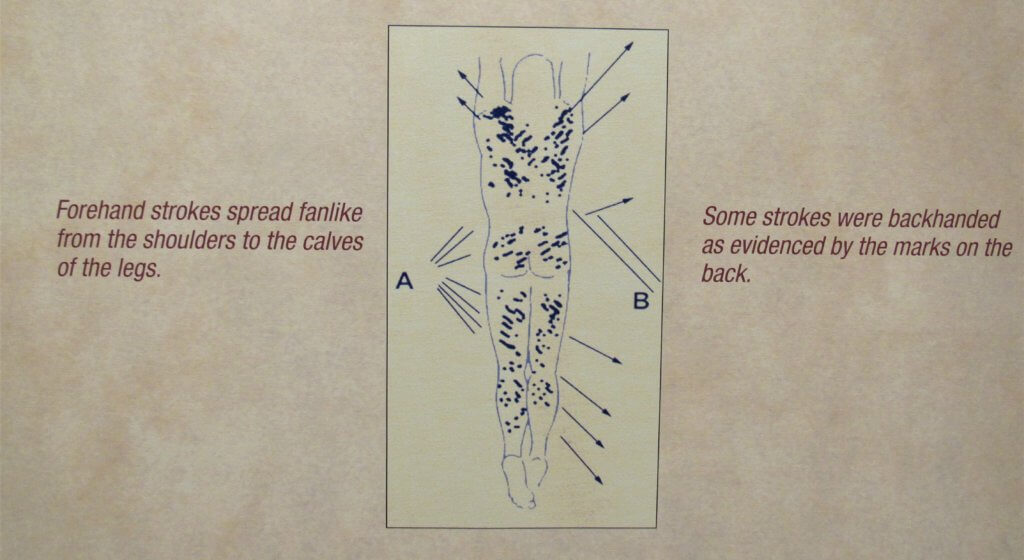
After Jesus is Flagellated
Flagellation proved not good enough for the crowd. They demanded more. The Temple leaders egged the crowd on to demand more. Eventually Pilate relented. Pilate condemned Jesus to death by crucifixion but washed his hands of any responsibility. This condemnation is the First Station of the Cross. Station 1 is located several hundred meters inside the Old City from Lion’s Gate. Today the 1st Station is occupied by a school. You will need permission to enter.
Across the road from Station 1 is the Monastery of Flagellation. This area is the location of Flagellation as well as where the Romans gave Jesus His cross to carry, or the 2nd Station of the Cross. This whole area was just outside Fortress Antonio. This area was where the Governor passed judgement. The stone pavement was called the Lithostrotos, or Gabbatha in Hebrew. This is the area, according to the Gospels, where the large crowd gathered to demand Jesus be crucified.
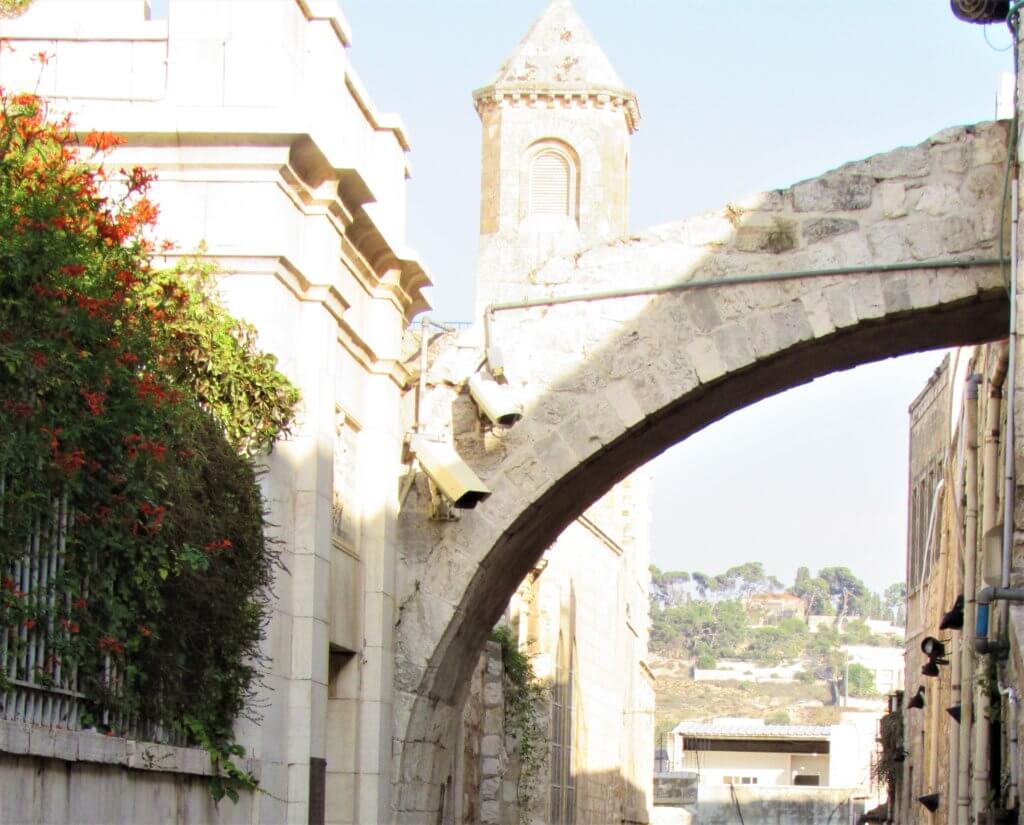
Ecce Homo Arch 
Mosaic of Jesus crossing the Lithostrotos
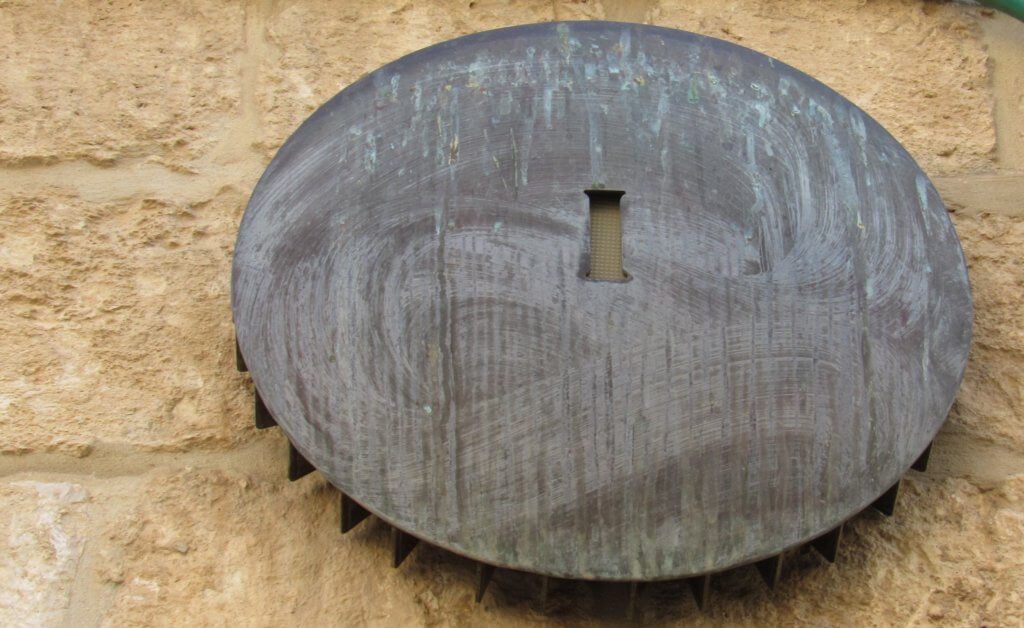
Disks like this signify the Station you are at 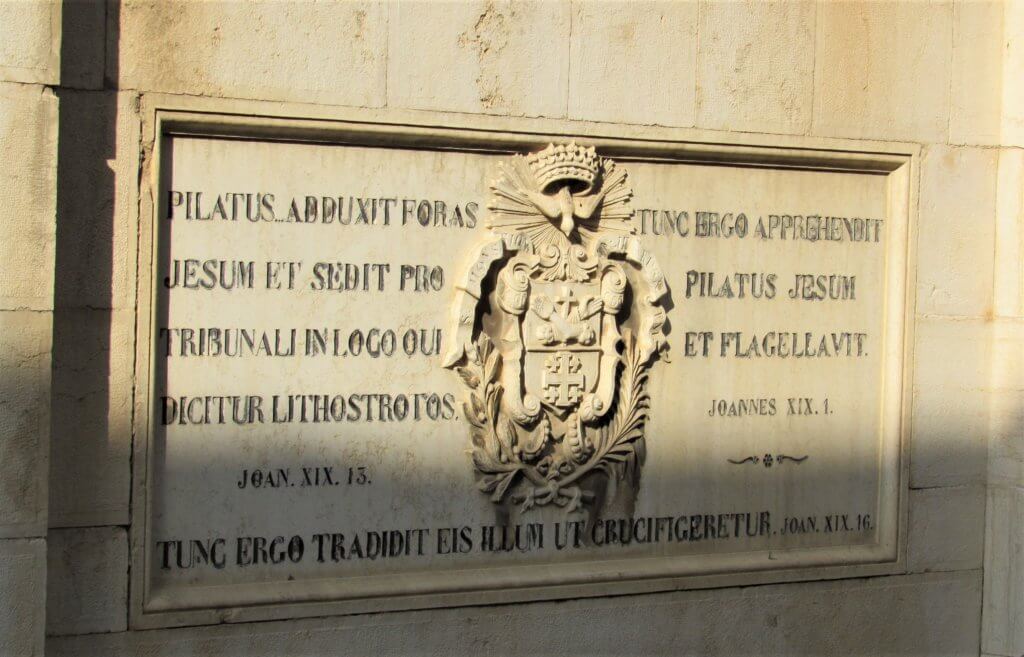
Wall relief outside the 1st and 2nd Station
Jesus starts His forced march
Jesus took His cross and started His forced march towards Golgotha. As you follow the route, you will pass an arch. This arch is near where Pilate addressed the crowd and said “Behold the man” or, Ecce Homo. Thus the arch’s name is the Ecce Homo Arch. As you walk along the streets, you notice the cobble stones and uneven footing. Jesus carried His cross across this surface while bleeding and being beat. The current road comes to a T and you turn left. Right at this turn is the 3rd Station of the Cross, where Jesus fell for the first time. Inside the building is a beautiful picture. I recommend you go inside to look at it. You need to go further inside and downstairs to find the 4th Station of the Cross. The 4th Station memorializes Mary meeting Jesus during the march to His death.
Traveling word of caution
This intersection, at the T by the 3rd Station, is probably the busiest intersection in the Old City on Friday afternoon. As Christian Pilgrims walk the Via Dolorosa, Jewish residents are trying to leave before their sabbath starts and Muslim residents are working their way further into the city for afternoon prayer. All three groups pass each other at this corner. Since it could be contentious, you will see many security guards milling about trying to keep the peace. Just have situational awareness and try to read the crowd.
Just a little further you come to another T and turn right to go uphill. This corner is the 5th Station of the Cross where the Romans forced Simon of Cyrene to aid Jesus in carrying His cross. You will see a spot in the rock wall near the 5th symbol. A lot of people believe Jesus touched the wall here so they want to touch the wall too. If you want to touch the wall go ahead. Just realize the City of Jerusalem has been conquered and destroyed several times since Jesus made His march and the actual location is probably a story or two below the street you are walking due to the destruction of buildings since then.
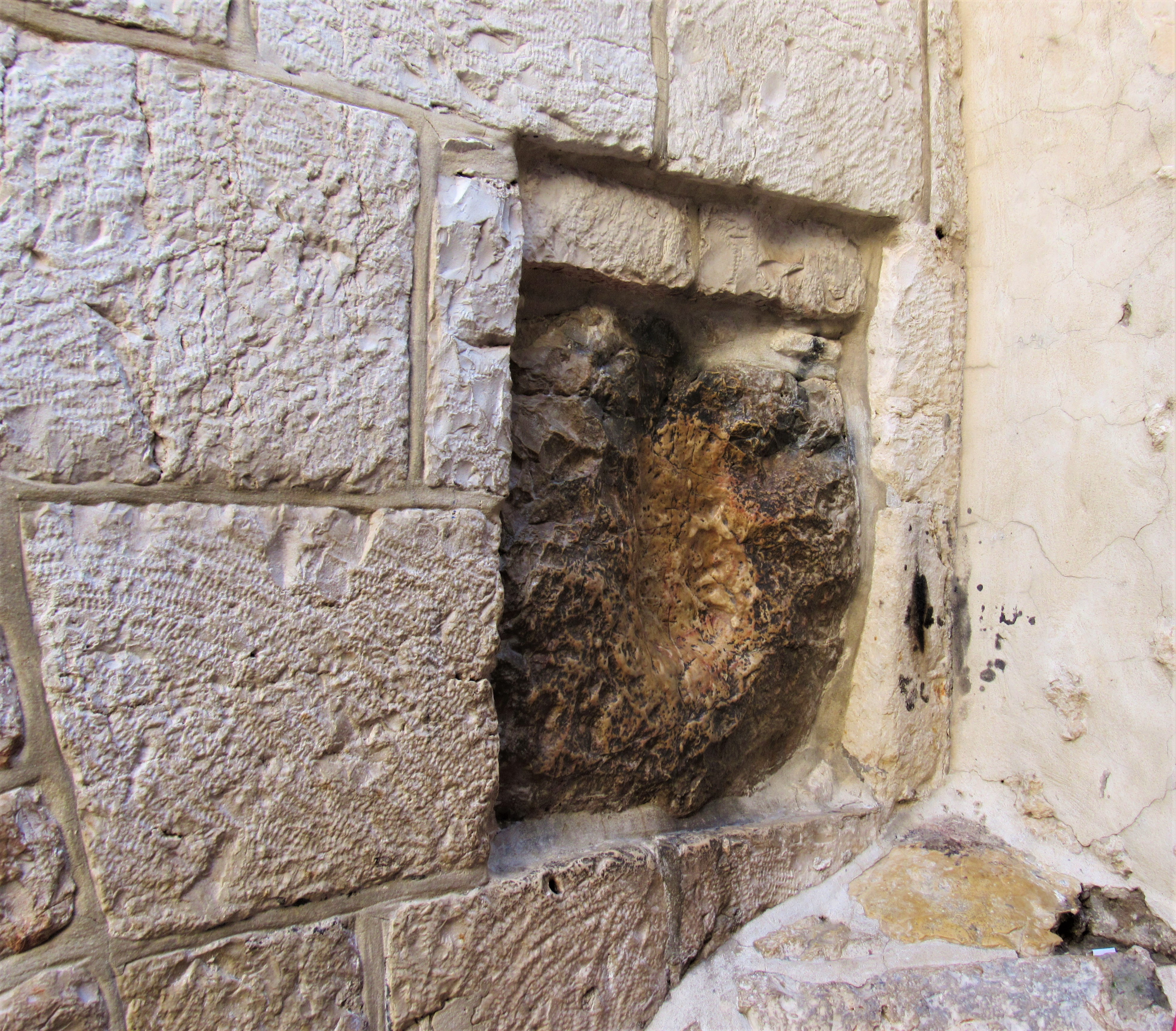
The “Hand Print” at the 5th Station 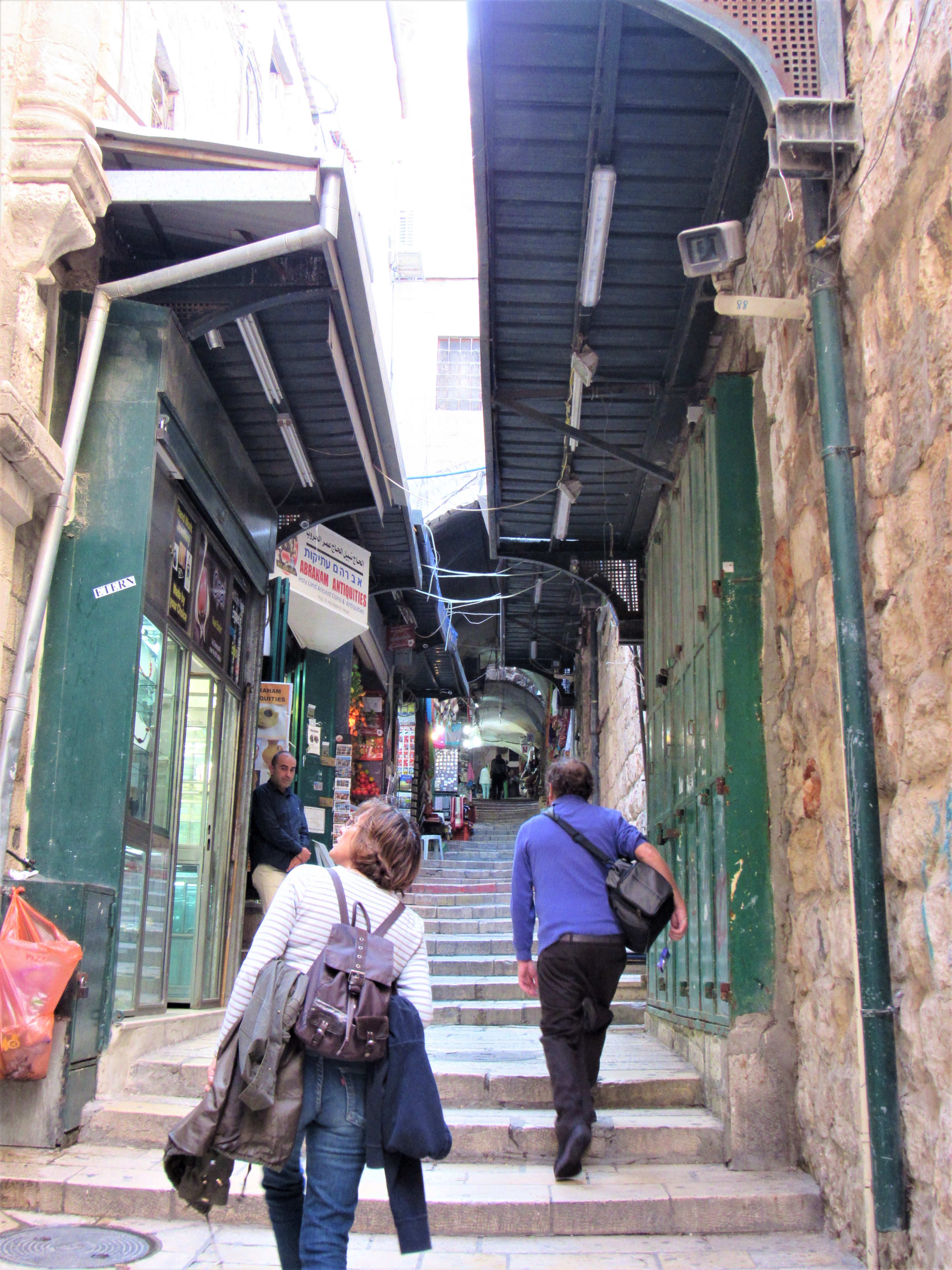
Turning up hill near the 5th and 6th Stations
Jesus climbs towards his death
As you climb the road you will see the 6th Station on your left. The 6th Station of the Cross symbolizes a woman wiping Jesus’s face during His march. The cloth used by the woman contained Jesus’s image. The name of the woman is not known, but many believe it to be Veronica.
There is a twist with the name. I believe the Veronica is mistakenly given as the her name. I believe the name stems from a Latin phrase for the cloth. The imprinted cloth held the true image of Jesus. The Latin for true image is vera icon. I believe the Latin phrase was misinterpreted at some point and modified into the name Veronica. Therefore, the woman said to have wiped Jesus’ face, is now Veronica. There is a small church at the 6th Station but it is not always open. If it is, please go in and explore. I only found it open once during my time there.
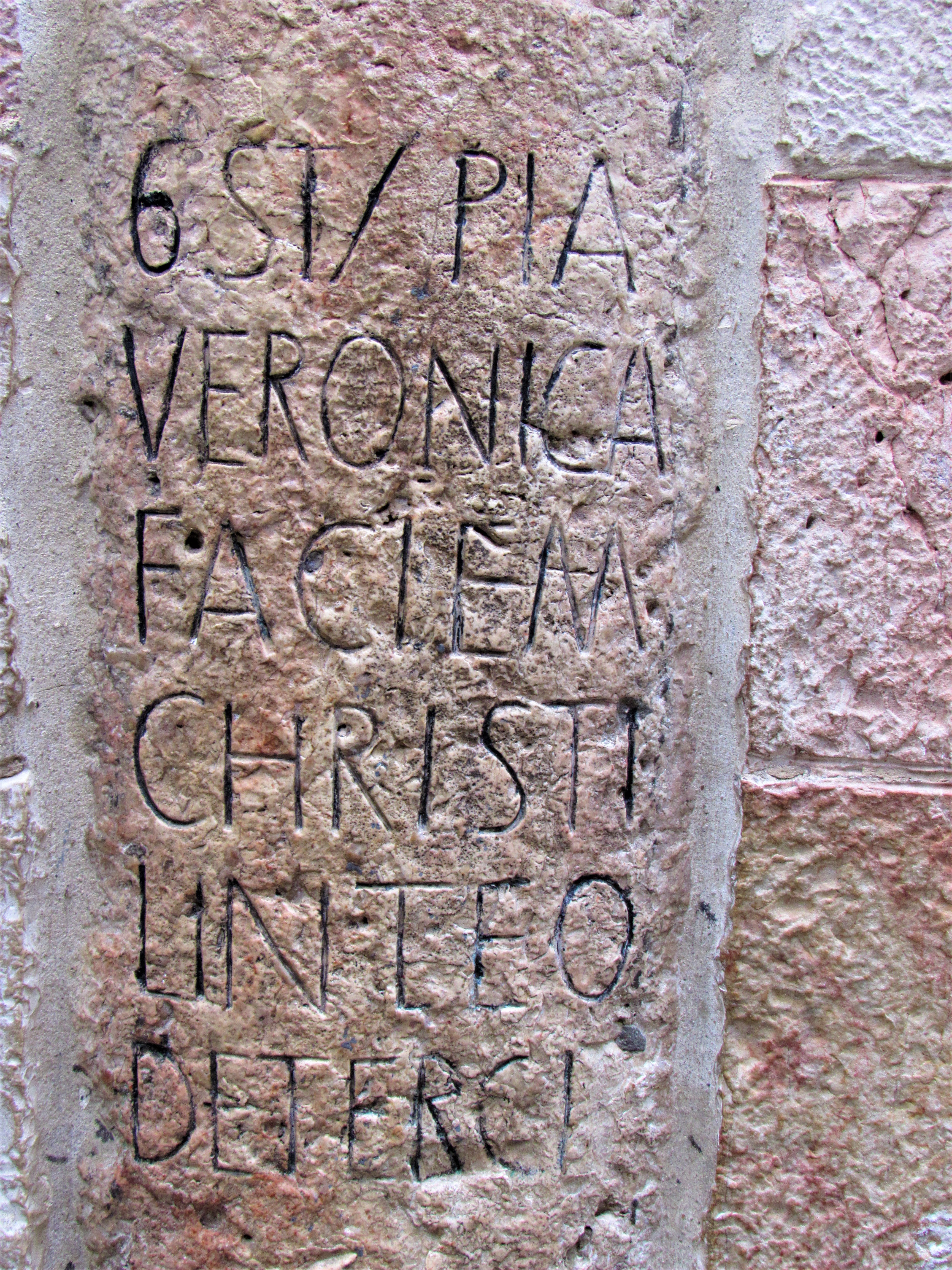
6th Station Wall 
6th Station Church
7th and 8th Station
Further up the hill you come to another T intersection. This T is the 7th Station. The 7th station is where Jesus fell for the second time. A short left, quick right and up the hill you will find the 8th Station of the Cross. The 8th Station commemorates where Jesus consoles the women of Jerusalem. The current road structure and building layout prohibits you from walking directly to the next Station. You will need to retrace your steps back towards the 7th Station.
To the 9th Station
When you get to the cross road, take a right, or head south. You will walk for several meters before you can climb some steps on your right in between several shops. Climb the steps and follow the route towards the west. As you walk you will finally see the top of the Church of the Holy Sepulchre’s blue dome. You are very close to Golgotha. Right after you see the top of the dome, you will find the 9th Station of the Cross. This is where Jesus fell for the 3rd and final time. At this point Jesus must have been exhausted. Tired, thirsty, beaten, bloodied, Jesus could see the cross roads and the rocky hill where the Romans crucified criminals.
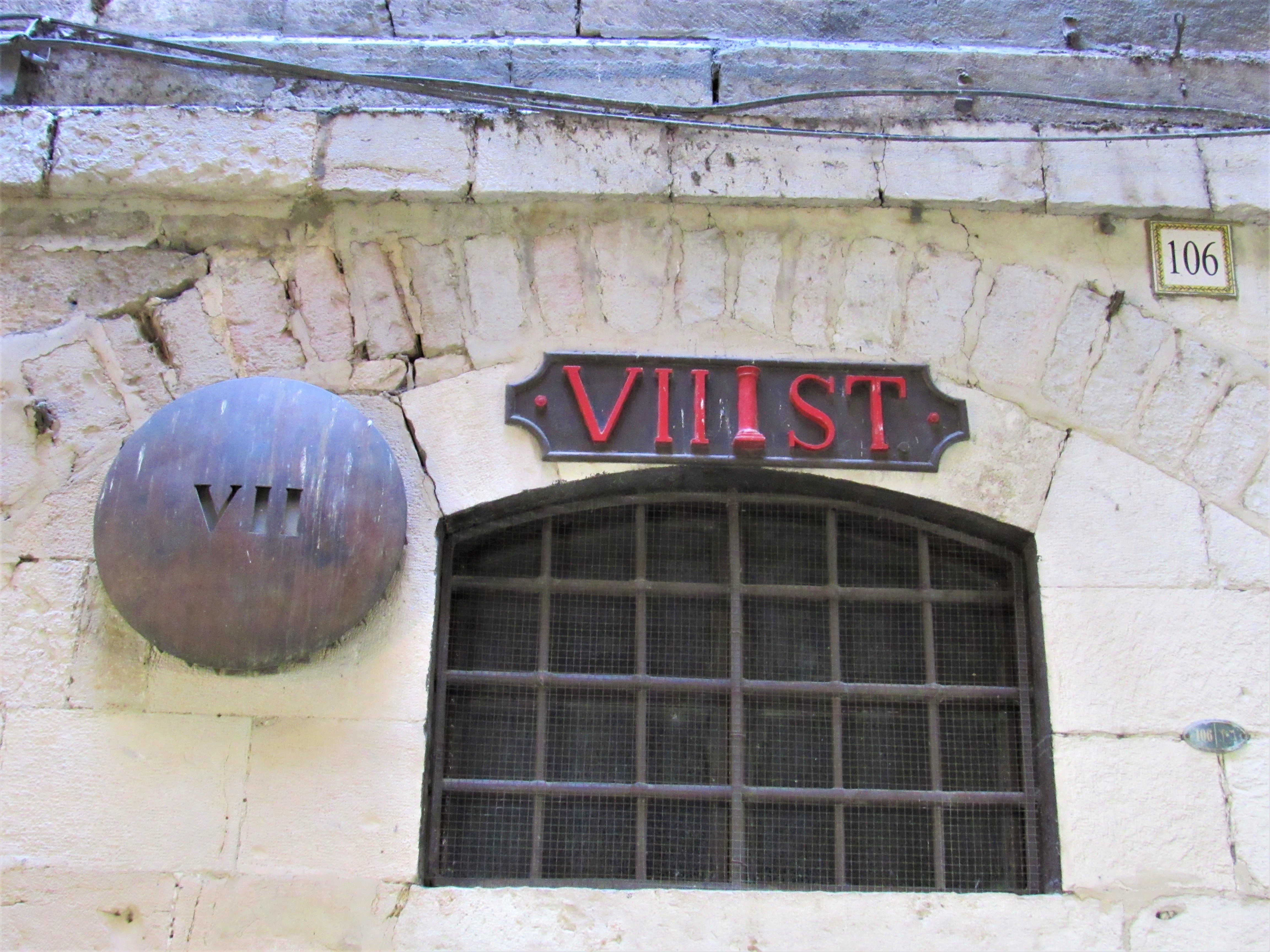
7th Station, where Jesus fell the 2nd Time 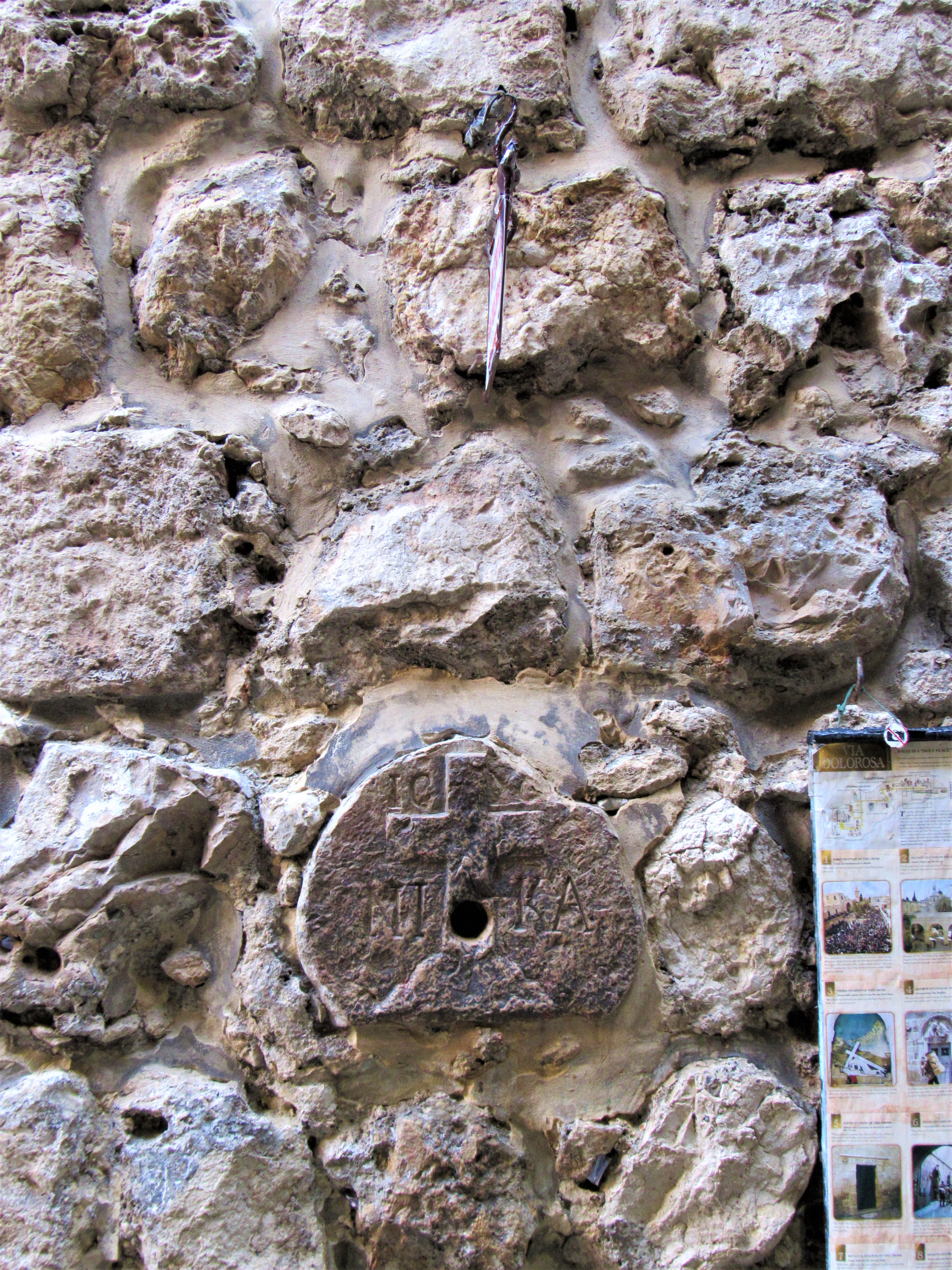
8th Station wall plaque
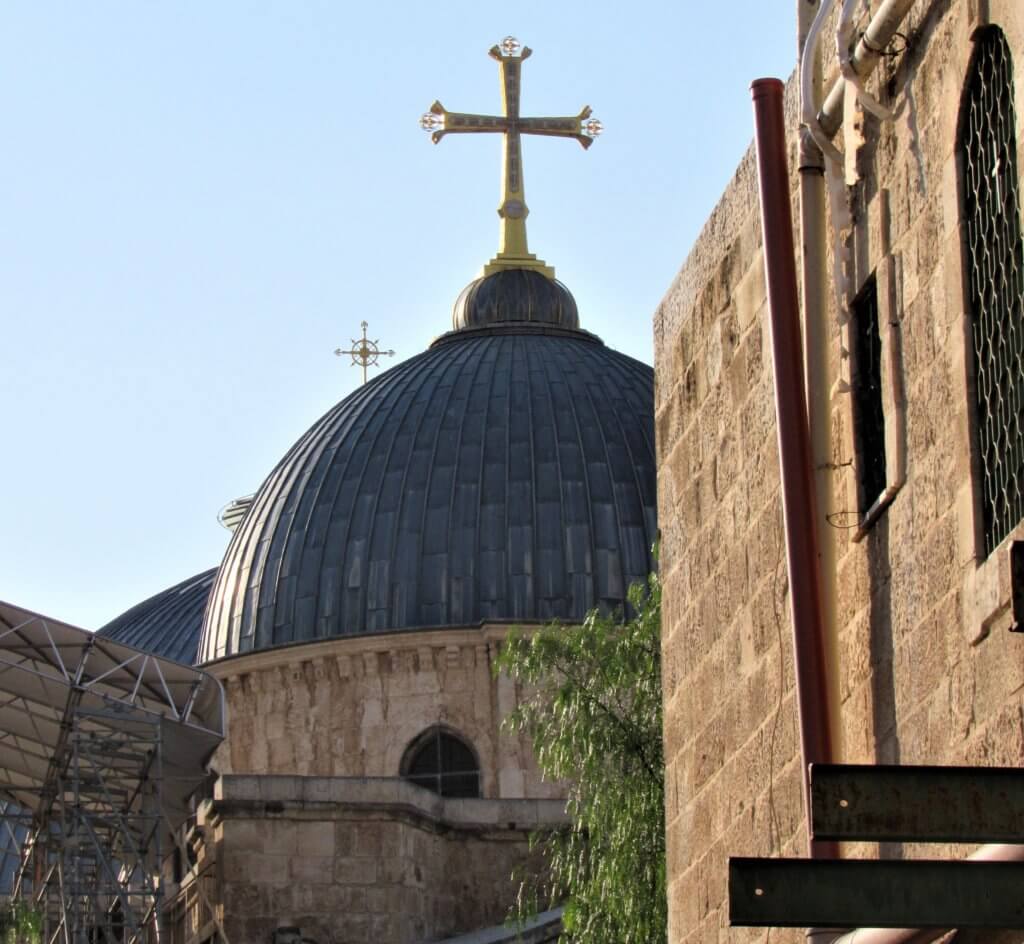
Before we move on, if you have time, and before you enter the rear courtyard of the Church of the Holy Sepulchre, there is a small Coptic Church near the 9th Station. For a small fee you can go down to a cistern. If my ‘map skills’ work, this is close to the cistern where the True Cross was found and may be on the other side of the wall, or very near to the wall, from the Inventio Crucis Chapel located down the steps within the Church of the Holy Sepulchre.
Jesus arrives at Golgotha and is crucified
Back on the Via Dolorosa you enter the rear courtyard of the Church of the Holy Sepulchre. This area is under the ministrations of the Ethiopian Orthodox. As you go through, you will see where beams came out from the back of the Church. My understanding is these beams were part of a building or room that housed crusaders and may even have been a cafeteria for them. I have not been able to confirm this.
In order to get inside you will need to go through a small door and into a Church called the Chapel of St Michael. After that you exit the Chapel into the Atrium of the Church of the Holy Sepulchre where you can enter (See me post on the Church of the Holy Sepulchre). Before going inside you can climb the stairs outside the Church doorway to see inside the Chapel of Sorrows. This Chapel is the 10th Station and is adjoined with the Chapel of the Crucifixion on the inside. When you get inside and go upstairs, you enter the Chapel of the Crucifixion where the 10th and 11th Station of the Cross meet.
The 10th Station
The 10th Station of the Cross is where Jesus is stripped of His garments. Roman law stated criminals were crucified naked. However, there was an exception for Jews. Jews were crucified wearing a loin cloth. Next, the 11th Station of the Cross signifies where the Romans nailed Jesus to the cross. There are conflicting theories for the cross. One theory is Jesus carried the entire cross, was nailed to the entire cross and then the entire cross was placed in a hole in the rock and elevated. The other theory is Jesus just carried the crossbeam, arrived at Golgotha and nailed to the crossbeam. Then the soldiers lifted the crossbeam onto the post already elevated and secured into the rock. I am not sure which theory is true.
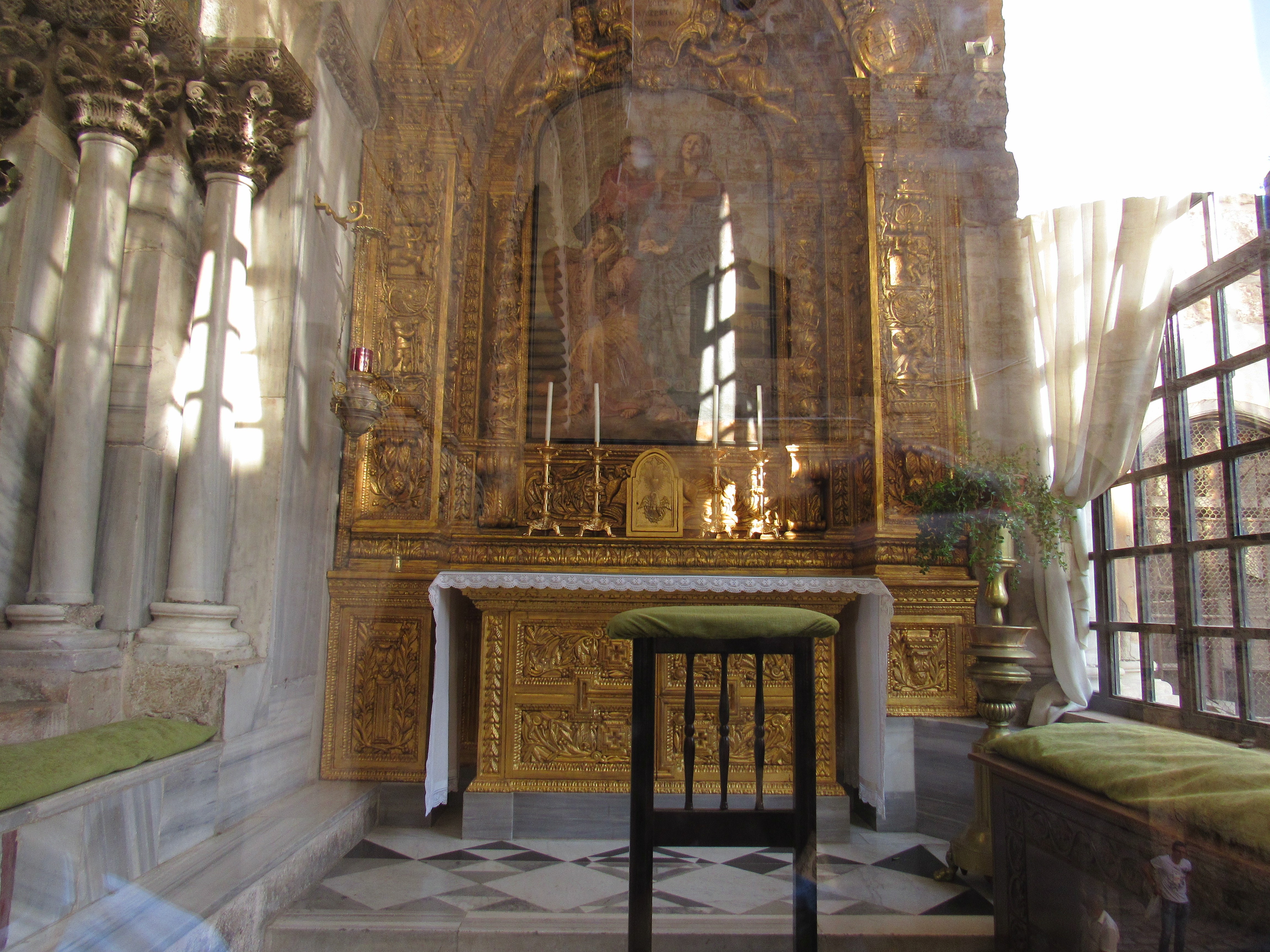
Inside the 10th Station 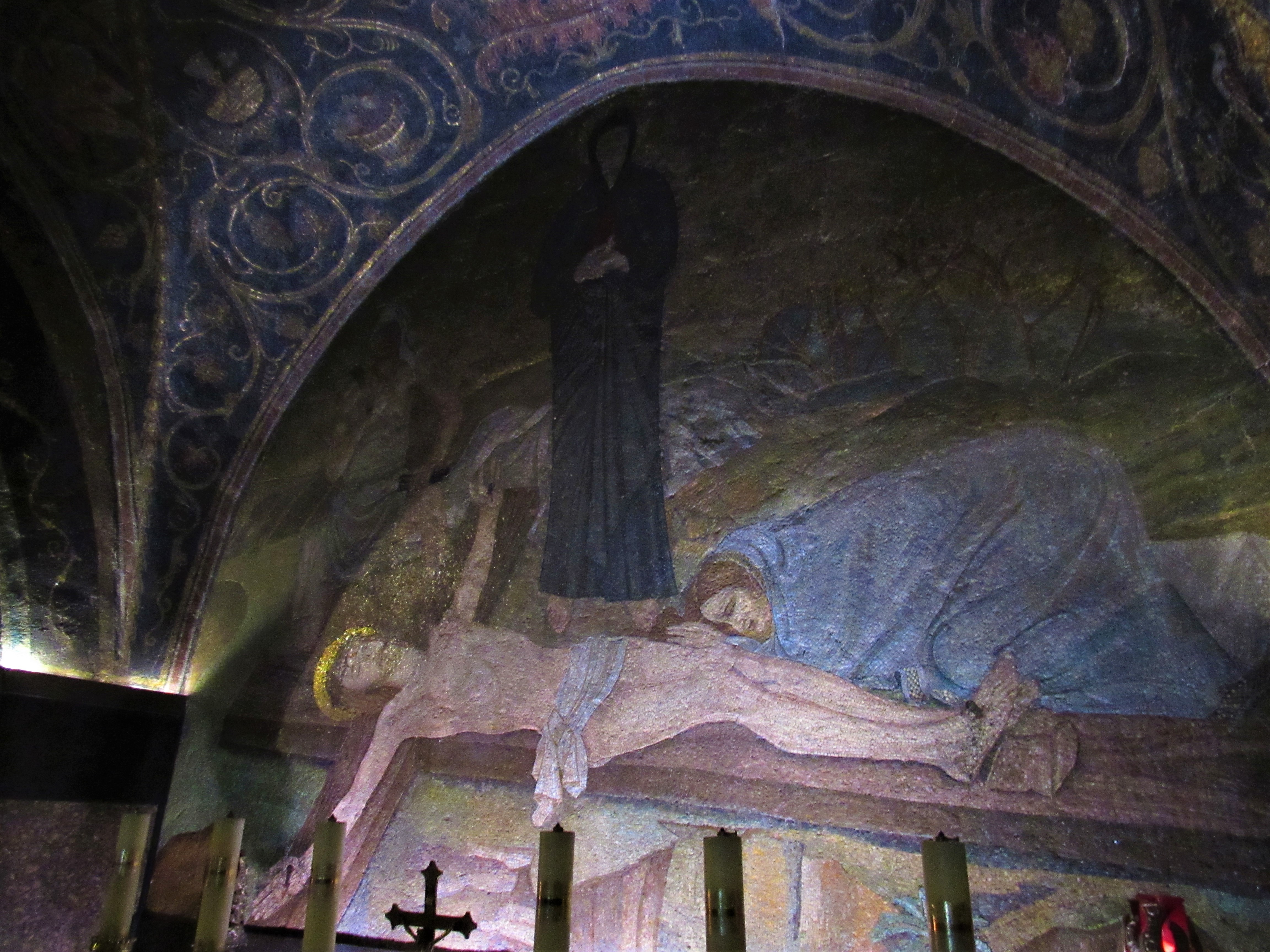
On top of Golgotha and the 11th Station
Either way, they lifted Jesus up and put him on display while suffering. I always struggled with understanding how someone died due to crucifixion. Did they die of blood loss? Did they die of hunger or thirst? No, the most likely cause was suffocation. How did they suffocate? They suffocated because they had to continually move between intense pain in the feet and being able to breath. If they lifted up in order to open the diaphragm to breath, the pain in the feet was intense. To relieve the pain, they squatted down, causing pain in the arms/hands and restricting their ability to breath. After several hours, criminals succumbed to suffocation because their body gave out. Sometimes Romans would want to quicken the death. The procedure to quicken death involved breaking the criminal’s legs. Once done, the criminals could not move up to breath so therefore they suffocated quicker.
Jesus dies for the sins of mankind
The 12th Station of the Cross is located further inside from the 10th and 11th Station. Jesus was placed between two criminals. This part of the story is well told in the Gospels and I will omit it from here. However, this is where Jesus died on the cross. This is the 12th Station. After His death, Jesus is taken down from the cross. The Stone of Unction, where Jesus in prepared for burial is the 13th Station of the Cross.
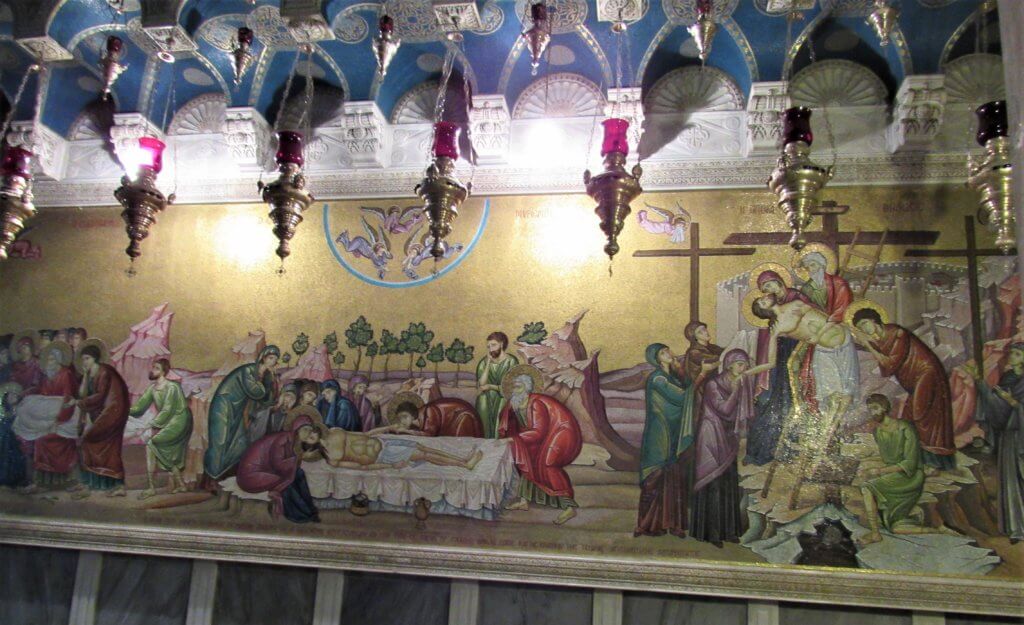
Another part of this event confused me for years. Why, after taking Jesus down, did they only partly prepare him for burial? Why were the two women going back on Sunday morning? The answers stem from Jewish faith. Jesus died on a Friday. The Friday before a holiday (Passover) where thousands of Pilgrims flocked to Jerusalem. The Temple Priests desired this greatly. They did not want Jesus to be held in prison over the ‘weekend’, giving His thousands of followers the chance to ‘rise up and demand for His release’. With this in mind, the trial was rushed (against Jewish law, but that is too long to discuss here) and the crowds forced Pilate into an action he didn’t necessarily want to make.
Common belief is Jesus died in the early afternoon, around three o’clock. Joseph of Arimathea needed permission to take Jesus down and bury him. This took time. Finally, with all permissions granted, they took Jesus’s body down from the cross. The procedure to prepare His body started. His body needed to be cleaned and wrapped according to Jewish tradition. Before His followers were complete, sundown occurred. Sundown on a Friday. Sundown of the Passover. The Temple Guards blew the Shofar (a horn), signifying the start of the sabbath (Shabbat) at sundown. Jewish law prohibits working during Shabbat. Therefore, Jesus’s followers could not continue working to prepare His body. With His body only partially prepared, they placed Jesus in the tomb and therefore His followers needed to come back on Sunday to finish the procedures.
Jesus is laid in the tomb
This leads us to the 14th Station of the Cross – Jesus is laid in the tomb. There is evidence that 1st century tombs like Jesus’s tomb contained two sections. A front section for the preparation and a rear section for burial, where the body would decompose before the bones placed in an ossuary, or bone box.
Before dying Jesus said he would rise again in three days. To prevent His followers from claiming he had risen, the Romans placed guards at the tomb to ensure no one rolled the stone away and took His body out to claim he had risen. It is important to note, Jewish leaders feared this scenario, so they asked the Romans for help and were granted the guard for the tomb. On Sunday morning, the two women arrived to find no guards, the stone rolled away and the tomb empty. The women ran to His Apostles to tell them. Two Apostles ran back to the tomb and found no one inside and the cloth used to wrap Jesus tossed in a corner. Jesus had risen, broken the chains of death and the veil was torn in the Temple.
Brief history of the Via Dolorosa
Through history, the numbers and locations of the Stations of the Cross changed. Due to the splitting of the Christian religion into different denominations, different paths were recognized. Pilgrims in the Middle Ages found 8 stations to follow. At the same time, Europeans believed tradition held 14 stations. The Christians in Jerusalem submitted to the Europeans and added 6 more stations.
Even today, the starting locations and ending locations for different denominations is different. My description above is the main route followed by the Byzantine pilgrims. My description is from the route I followed with the crowds on Good Friday and the route Jean-Marc and I gave tours of. However, the most important objective for the Christian faithful is the honoring of Jesus’s sacrifice and His rising from the dead.
Here is a video with excerpts from Good Friday Mass and the Via Dolorosa made in April 2016.
My advice
I suggest if you have the time, take a couple of hours to walk the Via Dolorosa. You can do it faster, but you will miss the significance and the raw agony of the route. Really think and contemplate what Jesus endured before and during His march. Try to ignore the shops and vendors as you take the route. Get into and live the experience. Feel the uneven stones, the incline and crush of the crowded streets. This is what Jesus experienced. If you want to visit the shops, go back later. Immerse yourself into the sights, sounds and smells of the Via Dolorosa.
The Via Dolorosa is a unique glimpse into the past. The story of its significance is retold in some degree every year, but growing up I did not fully appreciate or understand it. As with most things I witnessed and learned in Israel, my understanding became four dimensional as I explored the Holy Land. What I learned growing up was two dimensional at best. Retracing the steps, digging into the history and talking with people that live there now made my understanding blossom. I walked this dozens of times and I learned something new every time. If you have the chance, take the opportunity and explore the Via Dolorosa. As always, thank you for reading, stay safe and I wish you good luck traveling.
UPDATED Input from 2021: This year I found the Custodia Terræ Sanctæ Facebook page. They further break down the Stations of the Cross and have links to streaming Mass services. Please follow them or visit their webpage!
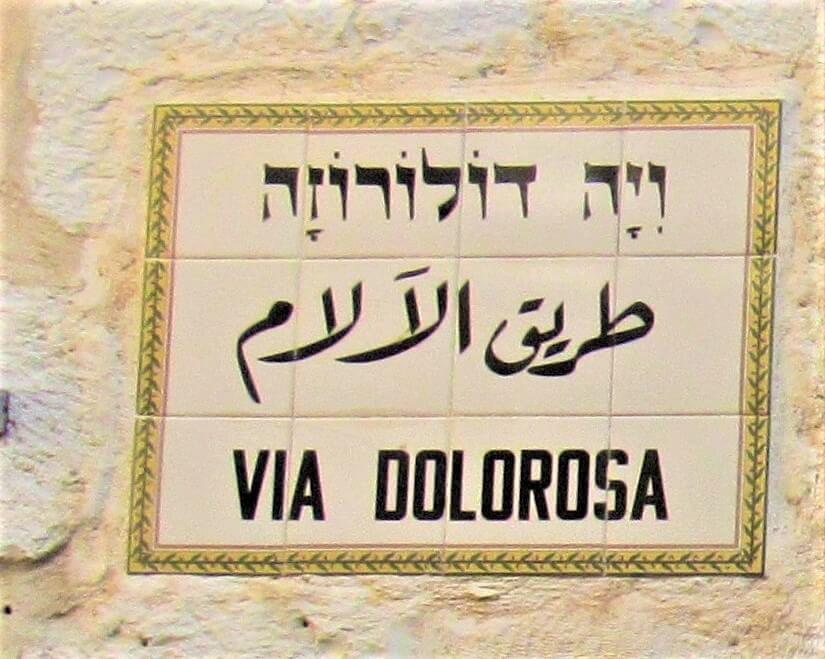


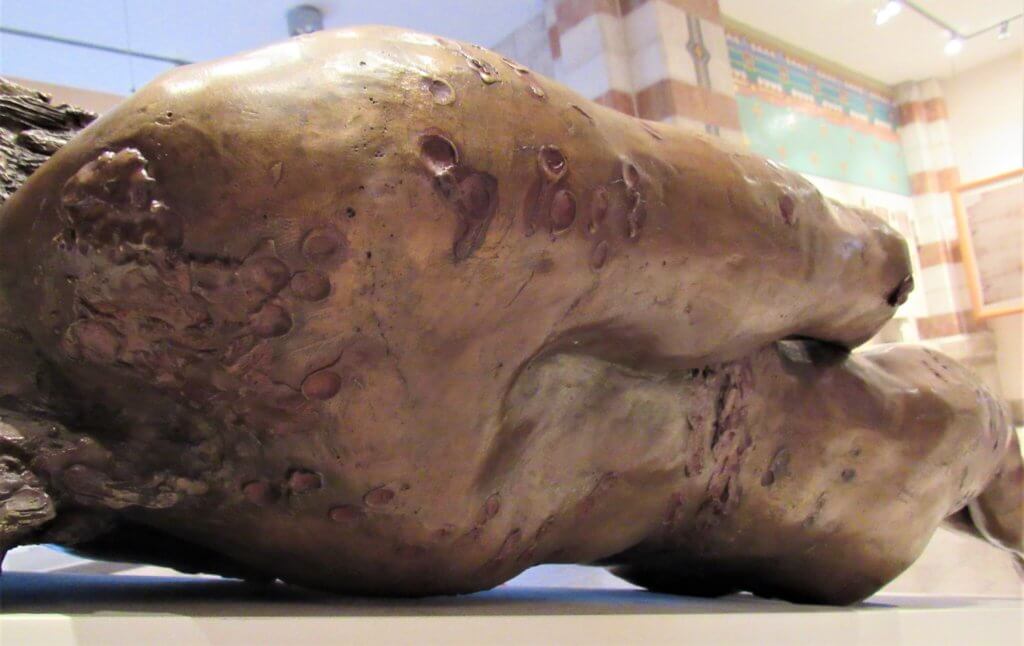
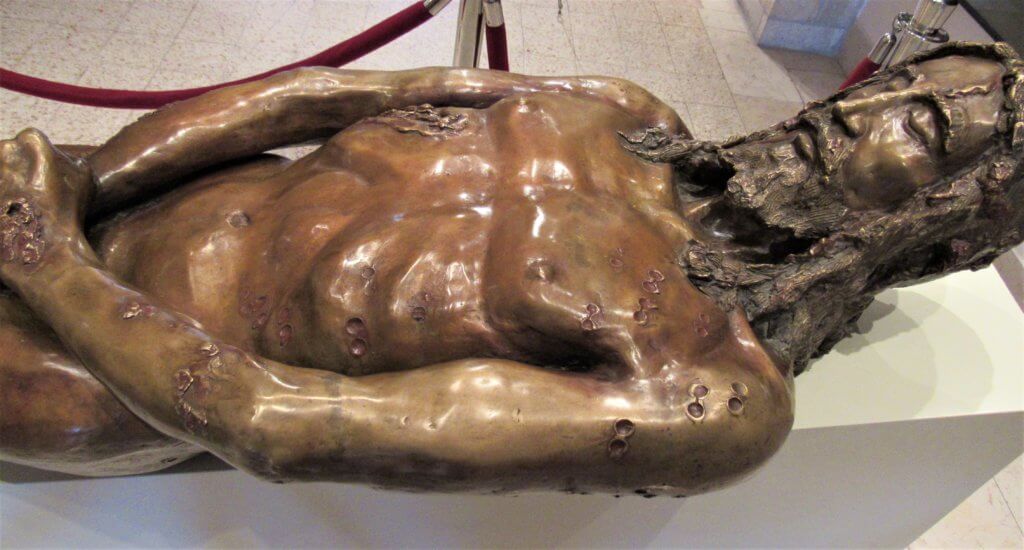
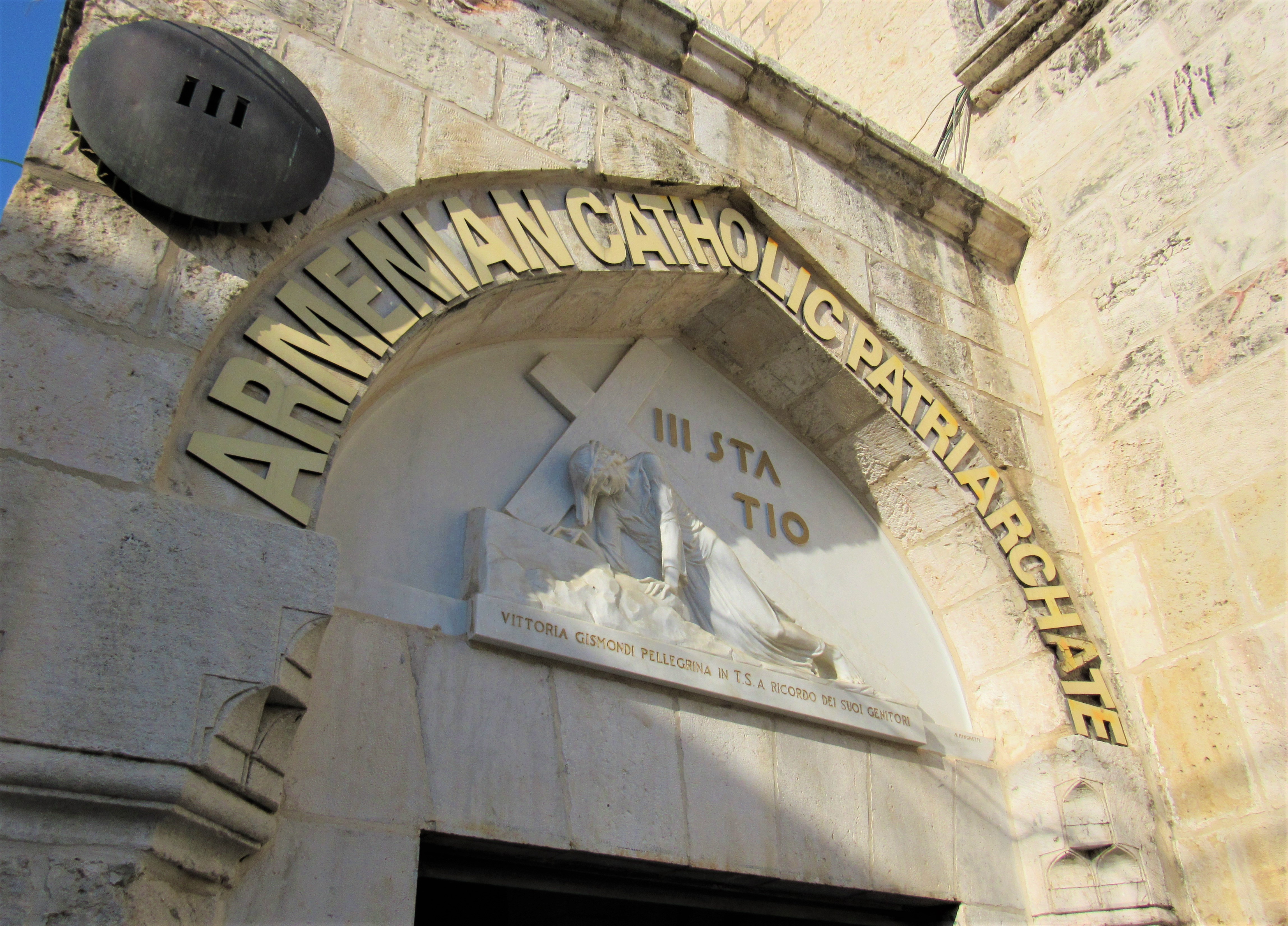
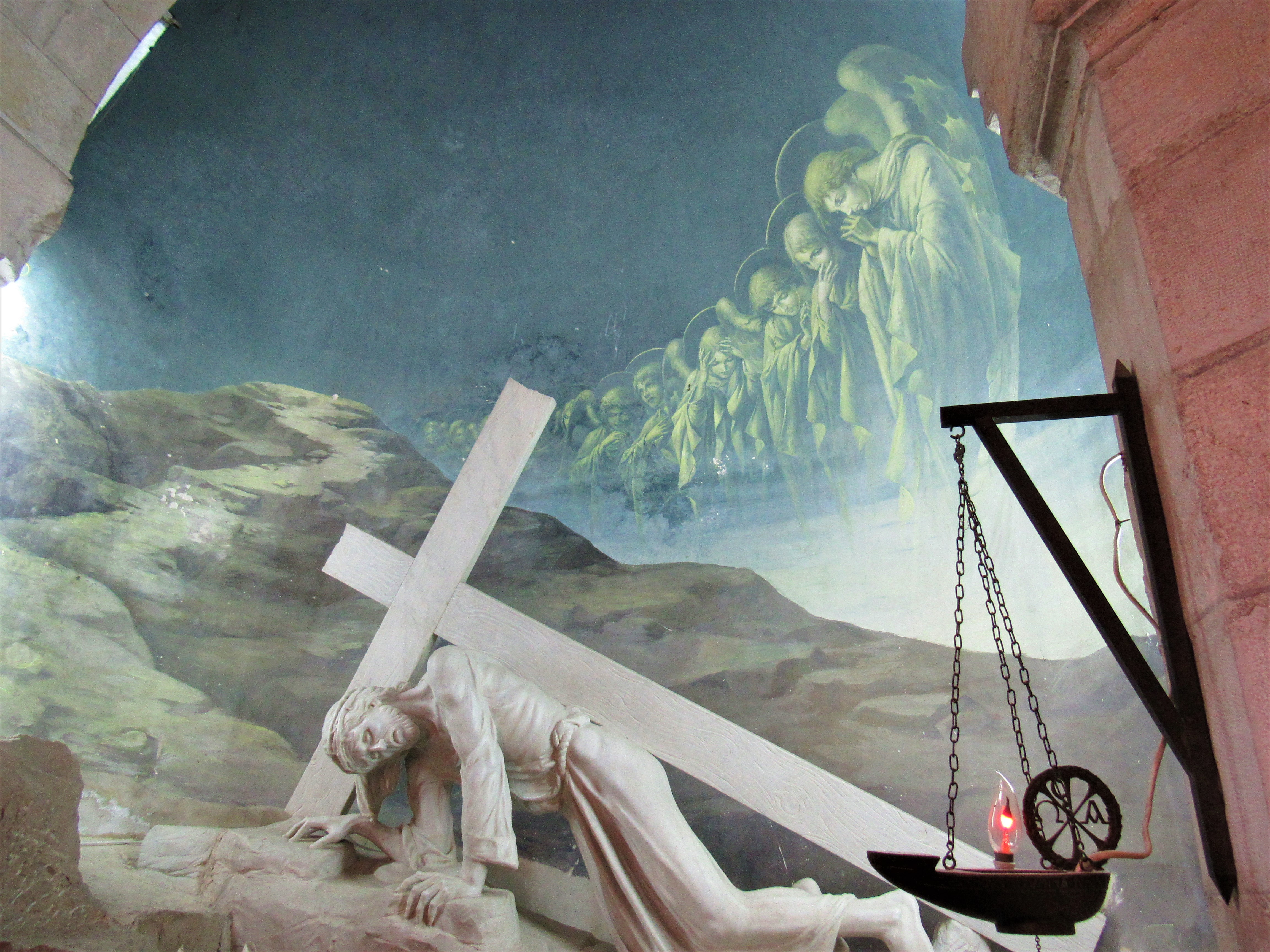
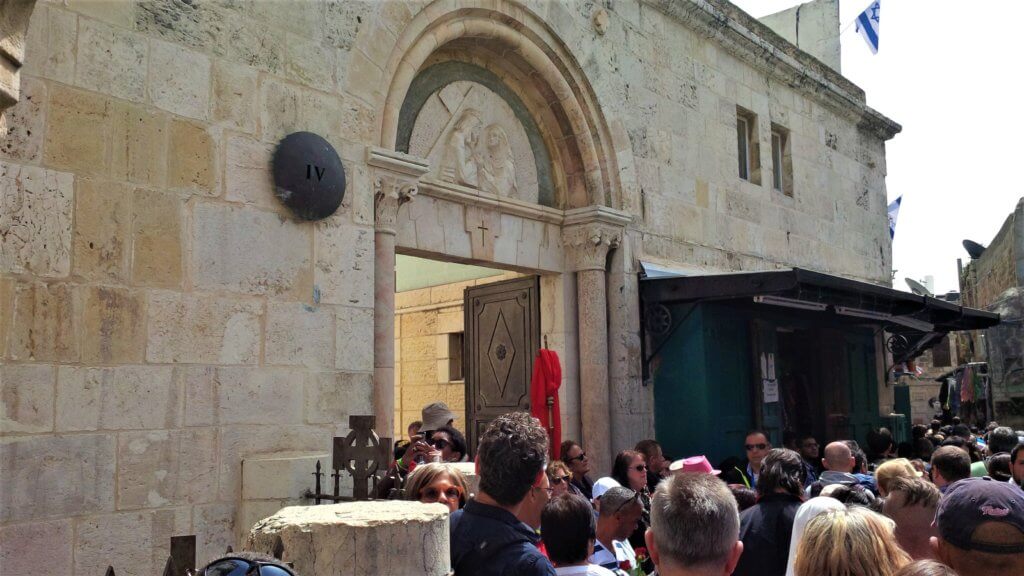
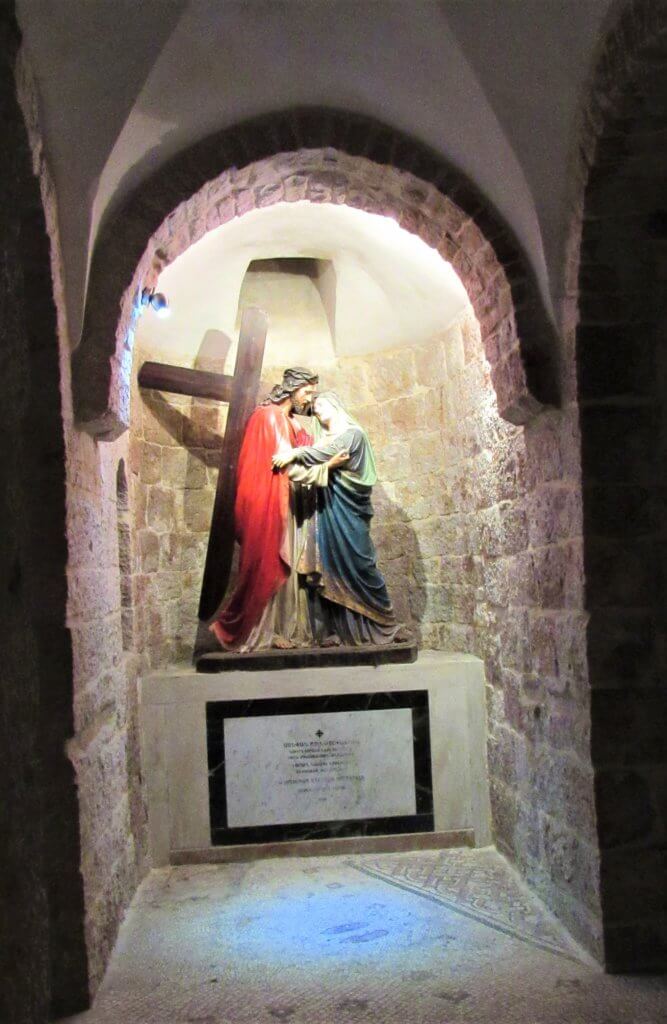
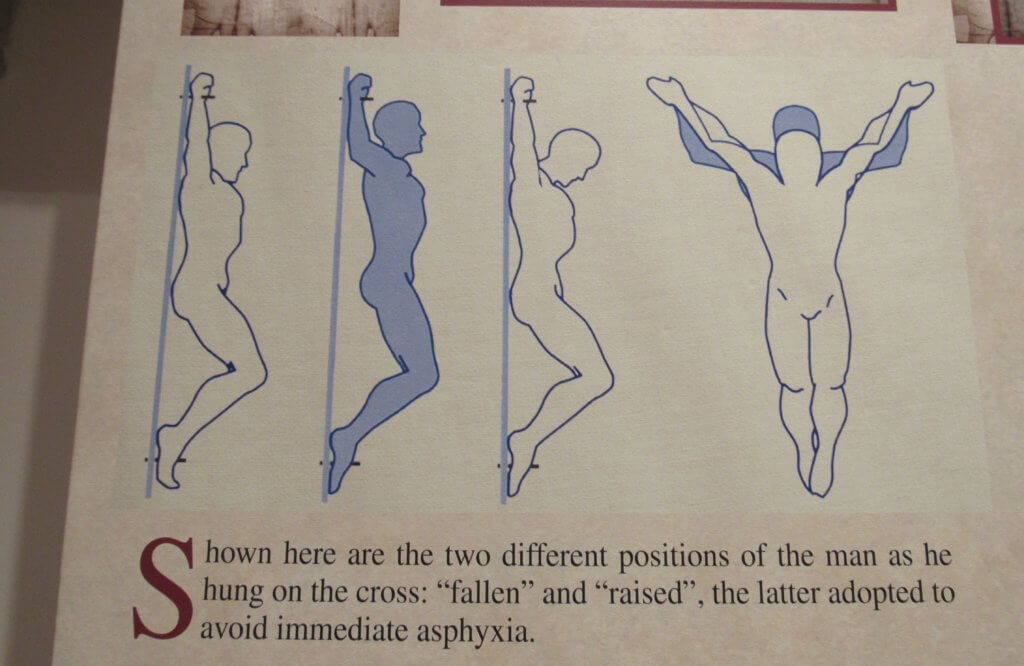
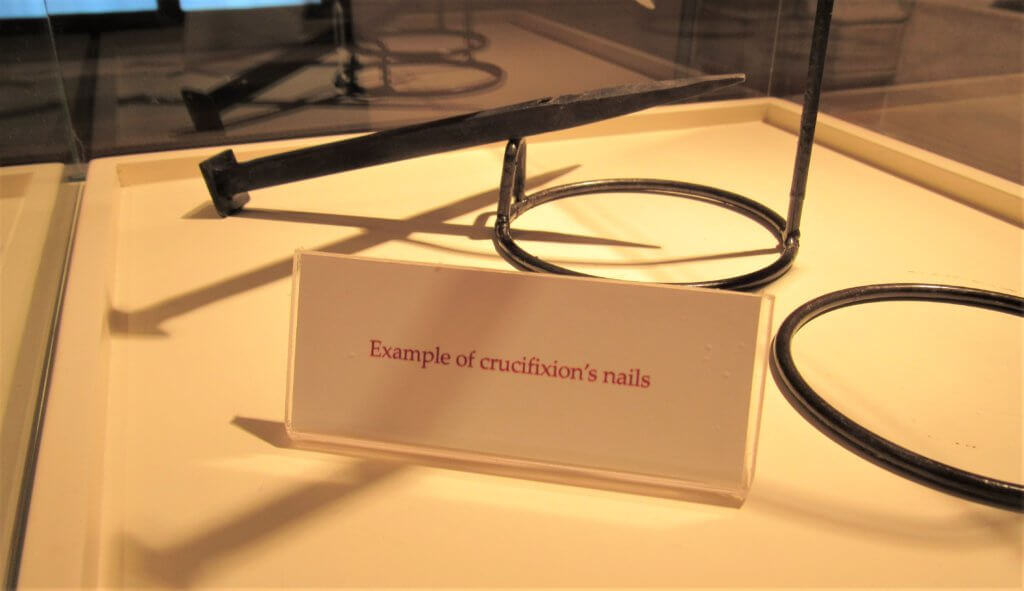
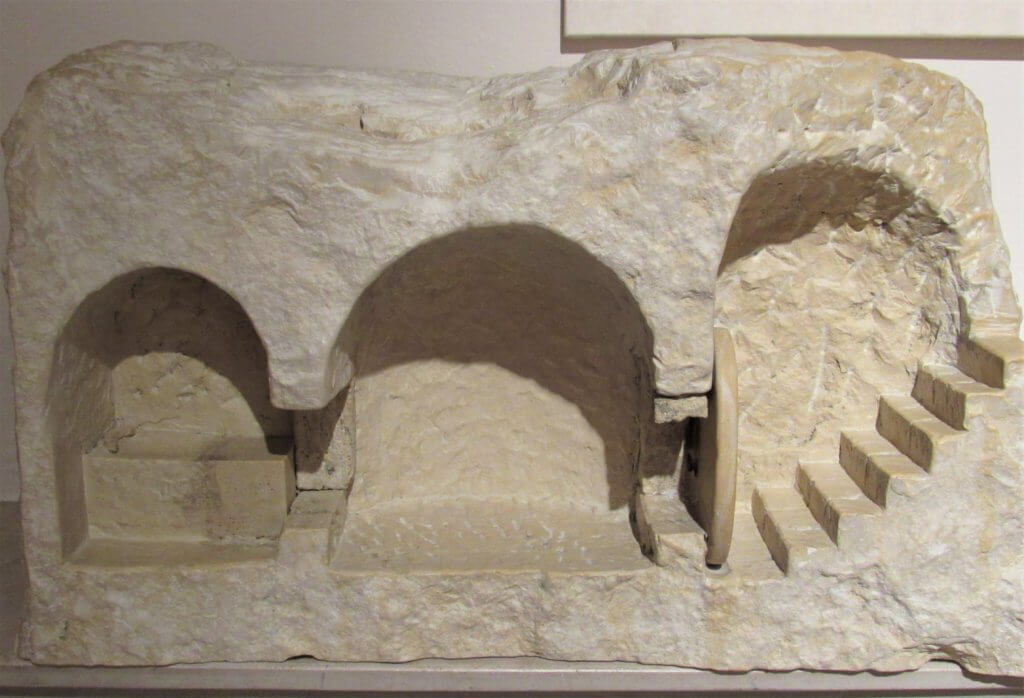

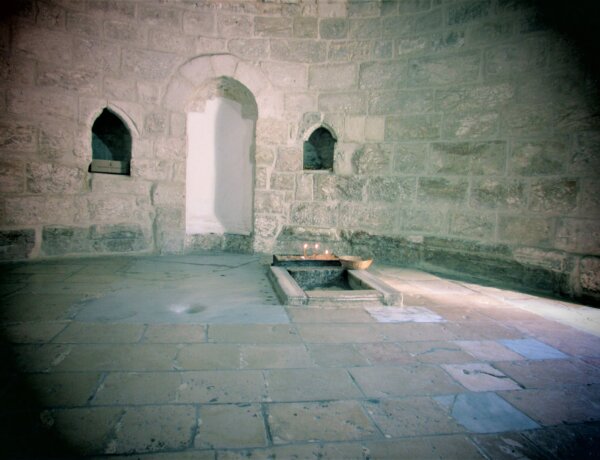


1 Comment
A Pilgrimage to Tolkien’s Oxford England - Beyond Last Week
June 5, 2022 at 11:59 am[…] Nazareth, down the Jordan River Valley, and all around and inside the Old City of Jerusalem and the Via Dolorosa. Some people make pilgrimages to more unique locations. When an opportunity to travel to the […]